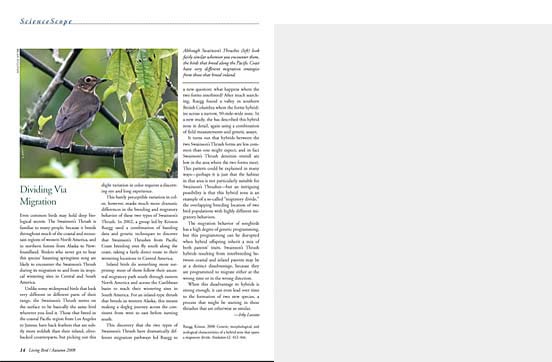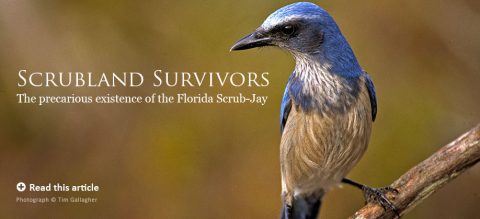Dividing Via Migration: Swainson’s Thrush
By Irby Lovette October 15, 2008
Even common birds may hold deep biological secrets. The Swainson’s Thrush is familiar to many people, because it breeds throughout much of the coastal and mountain regions of western North America, and in northern forests from Alaska to Newfoundland. Birders who never get to hear this species’ haunting springtime song are likely to encounter the Swainson’s Thrush during its migration to and from its tropical wintering sites in Central and South America.
Unlike some widespread birds that look very different in different parts of their range, the Swainson’s Thrush seems on the surface to be basically the same bird wherever you find it. Those that breed in the coastal Pacific region from Los Angeles to Juneau have back feathers that are subtly more reddish than their inland, olive-backed counterparts, but picking out this slight variation in color requires a discerning eye and long experience.
This barely perceptible variation in color, however, masks much more dramatic differences in the breeding and migratory behavior of these two types of Swainson’s Thrush. In 2002, a group led by Kristen Ruegg used a combination of banding data and genetic techniques to discover that Swainson’s Thrushes from Pacific Coast breeding sites fly south along the coast, taking a fairly direct route to their wintering locations in Central America.
Inland birds do something more surprising: most of them follow their ancestral migratory path south through eastern North America and across the Caribbean basin to reach their wintering sites in South America. For an inland-type thrush that breeds in western Alaska, this means making a dogleg journey across the continent from west to east before turning south.
This discovery that the two types of Swainson’s Thrush have dramatically different migration pathways led Ruegg to a new question: what happens where the two forms interbreed? After much searching, Ruegg found a valley in southern British Columbia where the forms hybridize across a narrow, 50-mile-wide zone. In a new study, she has described this hybrid zone in detail, again using a combination of field measurements and genetic assays.
It turns out that hybrids between the two Swainson’s Thrush forms are less common than one might expect, and in fact Swainson’s Thrush densities overall are low in the area where the two forms meet. This pattern could be explained in many ways—perhaps it is just that the habitat in that area is not particularly suitable for Swainson’s Thrushes—but an intriguing possibility is that this hybrid zone is an example of a so-called “migratory divide,” the overlapping breeding location of two bird populations with highly different migratory behaviors.
The migration behavior of songbirds has a high degree of genetic programming, but this programming can be disrupted when hybrid offspring inherit a mix of both parents’ traits. Swainson’s Thrush hybrids resulting from interbreeding between coastal and inland parents may be at a distinct disadvantage, because they are programmed to migrate either at the wrong time or in the wrong direction.
When this disadvantage to hybrids is strong enough, it can even lead over time to the formation of two new species, a process that might be starting in these thrushes that are otherwise so similar.
Ruegg, Kristen. 2008. Genetic, morphological, and ecological characteristics of a hybrid zone that spans a migratory divide. Evolution 62: 452–466.

All About Birds
is a free resource
Available for everyone,
funded by donors like you
American Kestrel by Blair Dudeck / Macaulay Library



